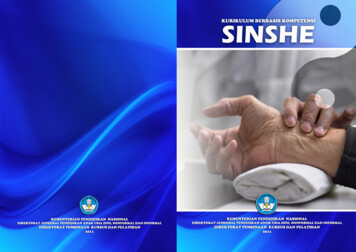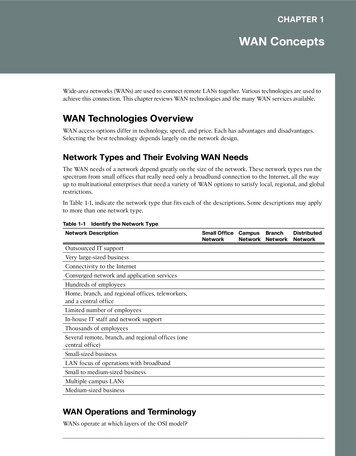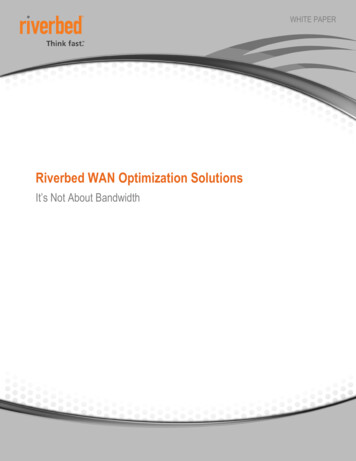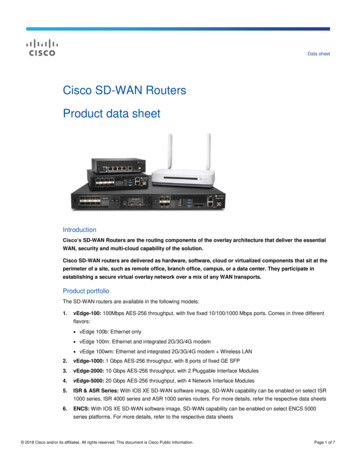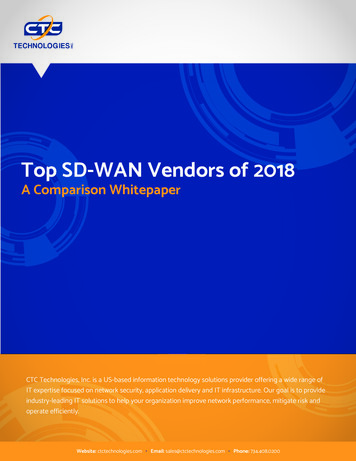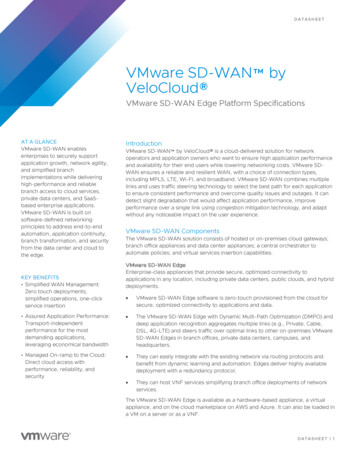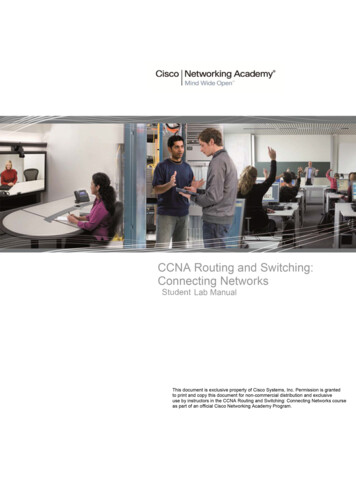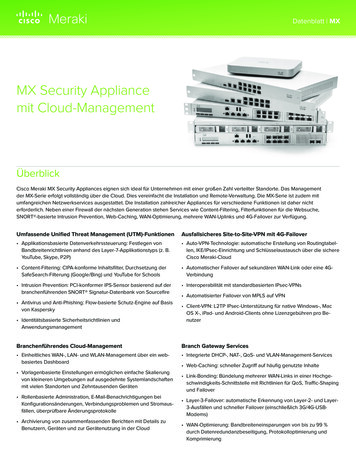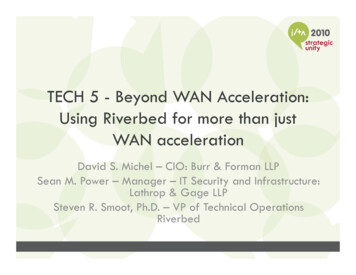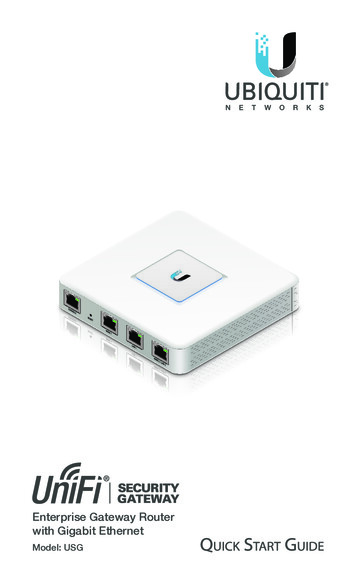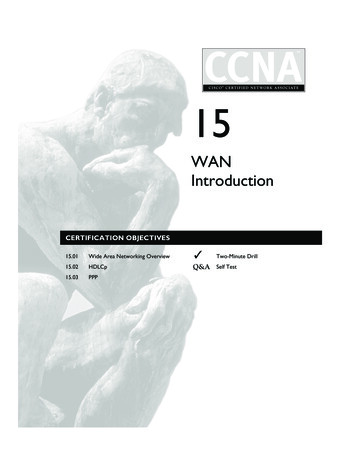
Transcription
Color profile: Generic CMYK printer profileCertPrs8Composite Default screen/ CCNA Cisco Certified Network Associate Study Guide / Deal / 222934-9 / Chapter 15Blind Folio 15:115WANIntroductionCERTIFICATION OBJECTIVES15.01Wide Area Networking Overview 15.02HDLCpQ&A Self Test15.03PPPD:\omh\CertPrs8\934-9\ch15.vpMonday, August 04, 2003 12:15:12 PMTwo-Minute Drill
Color profile: Generic CMYK printer profileCertPrs8 /Composite Default screen2Chapter 15:CCNA Cisco Certified Network Associate Study Guide / Deal / 222934-9 / Chapter 15WAN IntroductionThe last few chapters introduced you to configuring IP features on your Cisco router.This chapter introduces you to wide area networking (WAN) concepts and some basicpoint-to-point configurations, including HDLC and PPP. The two chapters followingthis, Frame Relay and ISDN, focus on packet-switched and dialup connections, respectively.CERTIFICATION OBJECTIVE 15.01Wide Area Networking OverviewTypically, LAN connections are within a company and WAN connections allowyou to connect to remote sites. Typically, you don’t own the infrastructure for WANconnections—another company, such as a telephone company, provides the infrastructure.WAN connections are usually slower than LAN connections. A derivative of WANsolutions is the metropolitan area network (MAN). MANs sometimes use high-speedLAN connections in a small geographic area between different companies, or divisionswithin a company. MANs are becoming more and more popular in large cities andeven provide connections over a LAN medium, such as Ethernet.One of the major factors when choosing aWAN or MAN provider is cost. These connectionsare billed in multiple ways: flat monthly lease cost,per-packet cost, per-minute cost, and many otherThe most important factormethods. On top of this, you have many solutionsin choosing a WAN service is cost.to choose from to solve your WAN connectionproblems. In order to choose the right solution, you’ll need to weigh your connectionrequirements, your traffic patterns, and the cost of the solution.Equipment and ComponentsWAN connections are made up of many types of equipment and components. Figure 15-1shows some of these WAN terms. Table 15-1 has a list of the terms and definitions.As you may recall from Chapter 2, a DCEterminates a connection between two sites andprovides clocking and synchronization for thatconnection; it connects to a DTE. The DCEIt is important to remembercategory includes equipment such as CSU/DSUs,the WAN terms in Table 15-1.NT1s, and modems. A DTE is an end-user device,D:\omh\CertPrs8\934-9\ch15.vpMonday, August 04, 2003 12:15:12 PM
Color profile: Generic CMYK printer profileCertPrs8Composite Default screen/ CCNA Cisco Certified Network Associate Study Guide / Deal / 222934-9 / Chapter 15Wide Area Networking OverviewFIGURE 15-13WAN termssuch as a router or PC, that connects to the WAN via the DCE equipment. In somecircumstances, the function of the DCE might be built into the DTE’s physicalinterface. For instance, certain Cisco routers can be purchased with built-in NT1sor CSU/DSUs in their WAN interfaces.TABLE 15-1WAN Terms and DefinitionsTermDefinitionCPE (customer premisesequipment)This is your network’s equipment, which includes the DCE (modem,NT1, CSU/DSU) and your DTE (router, access server).Demarcation pointThis is where the responsibility of the carrier is passed on to you; thiscould be inside or outside your local facility. Please note that this is alogical boundary, not necessarily a physical boundary.Local loopThis is the connection from the carrier's switching equipment to thedemarcation point.CO (central office) switchThis is the carrier's switch within the toll network.Toll networkThis is the carrier's internal infrastructure for transporting your data.D:\omh\CertPrs8\934-9\ch15.vpMonday, August 04, 2003 12:15:14 PM
Color profile: Generic CMYK printer profileCertPrs8 /Composite Default screen4Chapter 15:CCNA Cisco Certified Network Associate Study Guide / Deal / 222934-9 / Chapter 15WAN IntroductionConnection TypesAs mentioned at the beginning of this section, you have two major concerns whenchoosing a WAN solution: cost and the type of solution. There are many WAN solutionsto choose from, including the following: analog modems and ISDN for dialup connections,ATM, dedicated point-to-point leased lines (dedicated circuits), DSL, Frame Relay,SMDS, wireless (including cellular, laser microwave, radio, and satellite), and X.25.As you can see from this list, you have a lot of choices. Not all of these solutions will beavailable in every area, and not every solution is ideal for your needs. Therefore, oneof your first tasks is to have a basic understanding of some of these services. Chapter 1provided a brief overview of some of these services. This chapter covers some of theseservices briefly, and Chapters 16 and 17 expand on some of the others.Typically, WAN connections fall under one of four categories: Leased lines, such as dedicated circuitsor connections Circuit-switched connections, such as analogKnow about the four typesof WAN connections: leased lines, circuitswitched connections, packet-switchedconnections, and cell-switched connections.modem and digital ISDN dialup connections Packet-switched connections, such as FrameRelay and X.25 Cell-switched connections, such as ATMand SMDSThe following three sections will introduce you to these three connection types.Leased-Line ConnectionsA leased-line connection is basically a dedicated circuit connection between two sites.It simulates a single cable connection between the local and remote sites. Leased linesare best suited when both of these conditions hold: The distance between the two sites is small, making them cost-effective. You have a constant amount of traffic between two sites and need to guaranteebandwidth for certain applications.Even though leased lines can provide guaranteed bandwidth and minimal delay forconnections, other available solutions, such as ATM, can provide the same features.The main disadvantage of leased lines is their cost—they are the most expensiveWAN solution.Leased lines use synchronous serial connections, with their data rates ranging from2,400 bps all the way up to 45 Mbps, in what is referred to as a DS3 connection. AD:\omh\CertPrs8\934-9\ch15.vpMonday, August 04, 2003 12:15:14 PM
Color profile: Generic CMYK printer profileCertPrs8Composite Default screen/ CCNA Cisco Certified Network Associate Study Guide / Deal / 222934-9 / Chapter 15Wide Area Networking Overview5synchronous serial connection allows you tosimultaneously send and receive informationwithout having to wait for any signal from theRemember that leasedremote side. Nor does a synchronous connectionlines are used for short-distance connectionsneed to indicate when it is beginning to sendand when you have a constant amountsomething or the end of a transmission. Theseof traffic between sites with a needtwo things, plus how clocking is done, are theof guaranteed bandwidth.three major differences between synchronousand asynchronous connections—asynchronousconnections are typically used for dialup connections, such as modems.If you purchase a leased line, you will need the following equipment: DTEA router with a synchronous serial interface: this provides the datalink framing and terminates the WAN connection. DCEA CSU/DSU to terminate the carrier’s leased-line connection: thisprovides the clocking and synchronization for the connection.Figure 15-2 shows an example of the equipment required for a leased-line connection.The CSU/DSU is responsible for handling the physical layer framing, clocking, andsynchronization of the connection. Data link layer protocols that you can use forFIGURE 15-2Leased line exampleD:\omh\CertPrs8\934-9\ch15.vpMonday, August 04, 2003 12:15:17 PM
Color profile: Generic CMYK printer profileCertPrs8 /Composite Default screen6Chapter 15:CCNA Cisco Certified Network Associate Study Guide / Deal / 222934-9 / Chapter 15WAN Introductiondedicated connections include PPP, SLIP, and HDLC. SLIP is rarely used and isrestricted to IP traffic. SLIP has been replaced by PPP.Circuit-Switched ConnectionsCircuit-switched connections are dialup connections, as are used by a PC with a modemwhen dialing up an ISP. Circuit-switched connections include the following types: Asynchronous serial connectionsThese include analog modem dialupconnections and the standard telephone system, which is commonly referredto as Plain Old Telephone Service (POTS) by the telephone carriers. Synchronous serial connectionsThese include digital ISDN BRI and PRIdialup connections; they provide guaranteed bandwidth.Asynchronous serial connections are thecheapest form of WAN services but are alsothe most unreliable of the services. For instance,every time you make a connection using an analogAnalog connectionsmodem, there is no guarantee of the connectionare restricted by the FCC to 53 Kbps.rate you’ll get. With these connections, the topconnection rate in the U.S. is 53 Kbps, but depending on the quality of the connection,you might get something as low as 300 bps. The Federal Communications Commission(FCC) restricts analog data rates to 53 Kbps or less. Other countries might supporthigher data rates.The main problem with circuit-switched connections is that they are expensiveif you need to make connections over long distances, with a per-minute charge thatvaries, depending on the destination. Therefore, the more data you have to send,the more time it will take, and the more money it will cost.Asynchronous circuit-switched connections are typically used for home officeand low-speed backup connections, as well as temporary low-speed connections foradditional boosts in bandwidth when your primary link becomes congested or whenit fails. ISDN (discussed in Chapter 17) provides a digital circuit-switched connectionwith guaranteed data rates.With leased lines, as soon as the circuit is installed and you have configured yourDTE, the line remains up unless there is a problem with the carrier’s network or the DCEequipment. This is different from circuit-switched connections. These connectionsare temporary—you make a phone call to the remote DTE and when the line comesup, you transmit your data. Once you are done transmitting your data, the phoneconnection is terminated.D:\omh\CertPrs8\934-9\ch15.vpMonday, August 04, 2003 12:15:17 PM
Color profile: Generic CMYK printer profileCertPrs8Composite Default screen/ CCNA Cisco Certified Network Associate Study Guide / Deal / 222934-9 / Chapter 15Wide Area Networking Overview7If you will be using a circuit-switched analog connection, you’ll need this equipment: DTEA router with an asynchronous serial interface DCEA modemIf you will be using a circuit-switched digital connection, you’ll need this equipment: DTEA router with an ISDN interface DCEAn NT1 for a BRI or a CSU/DSUfor a PRIRemember that circuitswitched connections are typically usedto back up primary connections, provideadditional bandwidth boosts, and affordremote access to dialup users.Figure 15-3 shows an example of an analogcircuit-switched connection. With thisconnection, you’ll typically use PPP or HDLCfor the encapsulation: SLIP is rarely used.Packet-Switched ConnectionsWith leased lines and circuit-switched connections, a physical circuit is used to makethe connection between the two sites. With a leased line, the same circuit path isalways used. With circuit-switched connections, the circuit path is built every time aphone call is made, making it highly probable that the same circuit path will not beused for every phone call.Packet-switched connections use logical circuits to make connections between twosites. These logical circuits are referred to as virtual circuits (VCs). One advantage thatFIGURE 15-3Analog circuit-switched connectionD:\omh\CertPrs8\934-9\ch15.vpMonday, August 04, 2003 12:15:18 PM
Color profile: Generic CMYK printer profileCertPrs8 /Composite Default screen8Chapter 15:CCNA Cisco Certified Network Associate Study Guide / Deal / 222934-9 / Chapter 15WAN Introductiona logical circuit has over a physical one is that a logical circuit is not tied to anyparticular physical circuit. Instead, a logical circuit is built across any available physicalconnection. Another advantage of logical circuits is that you can build multiple logicalcircuits over the same physical circuit. Therefore, with a single physical connectionto a carrier, you can connect to multiple sites. This is not possible with leased lines:for each location you want to connect to, you need a separate physical circuit, makingthe cost of the solution much higher that one that uses logical circuits. Technologiesthat use packet switching and logical circuits include ATM, Frame Relay, SMDS, andX.25. From a cost perspective, packet-switched solutions fall somewhere betweencircuit-switched solutions and leased lines.The oldest of these four technologies is X.25, which is an ITU-T standard. X.25is a network layer protocol that runs across both synchronous and asynchronousphysical circuits, providing a lot of flexibility for your connection options. X.25 wasactually developed to run across unreliable connections. It provides both error detectionand correction, as well as flow control, at both the data link layer (by LAPB) and thenetwork layer (by X.25). In this sense, it performs a function similar to what TCP, atthe transport layer, provides for IP. Because of its overhead, X.25 is best delegated toasynchronous, unreliable connections. If you have a synchronous digital connection,another protocol, such as ATM or Frame Relay, is much more efficient.Frame Relay is a digital packet-switched service that can run only across synchronousdigital connections at the data link layer. Because it uses digital connections (whichhave very few errors), it does not perform any error correction or flow control as X.25does. Frame Relay will, however, detect errors and drop bad frames. It is up to a higherlayer protocol, such as IP’s TCP, to resend the dropped information.If you are setting up a Frame Relay connection, you’ll need the following equipment. DTEA router with a synchronous serial interface DCEA CSU/DSU to connect to the carrierFigure 15-4 shows an example of a Frame Relay connection. In this example, therouter needs only a single physical connection to the carrier to connect to multiplesites: this is accomplished via virtual circuits. Frame Relay supports speeds fromfractional T1 or E1 connections (56–64 Kbps) up to a DS3 (45 Mbps). Frame Relayis discussed in Chapter 16.ATM and SMDS are also packet-switched technologies that use digital circuits.Unlike Frame Relay and X.25, however, these services use fixed-length (53 byte)packets, called cells, to transmit information. Therefore, these services are commonlycalled cell-switched services. They have an advantage over Frame Relay in that theyD:\omh\CertPrs8\934-9\ch15.vpMonday, August 04, 2003 12:15:18 PM
Color profile: Generic CMYK printer profileCertPrs8Composite Default screen/ CCNA Cisco Certified Network Associate Study Guide / Deal / 222934-9 / Chapter 15Wide Area Networking OverviewFIGURE 15-49Frame Relay packet-switched connectioncan provide guaranteed throughput and minimal delay for a multitude of services,including voice, video, and data. However, they do cost more than Frame Relay services.SMDS, which was developed by BellCore,is precursor to ATM and has been replaced bythe latter service. ATM (sort of an enhancedFrame Relay) can offer a connection guaranteedRemember that packetbandwidth, limited delay, limited number ofswitched and cell-switched services areerrors, Quality of Service (QOS), and more.typically used when a router has onlyFrame Relay can provide some minimal guaranteesa single WAN interface but needs toto connections, but not the degree of precisionconnect to multiple remote sites.that ATM can. Whereas Frame Relay is limitedto 45 Mbps connections, ATM can scale to very high speeds; OC-192 (SONET), forinstance, affords about 10 Gbps of bandwidth.WAN Interfaces on Cisco RoutersCisco supports a wide variety of serial cables for their serial router interfaces. Here aresome of the cable types supported for synchronous serial interfaces: EIA/TIA-232,D:\omh\CertPrs8\934-9\ch15.vpMonday, August 04, 2003 12:15:19 PM
Color profile: Generic CMYK printer profileCertPrs8 /Composite Default screen10Chapter 15:CCNA Cisco Certified Network Associate Study Guide / Deal / 222934-9 / Chapter 15WAN IntroductionSynchronous serialinterfaces have either a DB-60 or DB-26connector for connecting to Cisco routers.EIA/TIA-449, EIA/TIA-530, V.35, and X.21.The end that connects to the DCE device isdefined by these standards. However, the endthat connects to the Cisco router is proprietaryin nature. Cisco’s cables have two different endconnectors that connect to the serial interfacesof their routers: DB-60Has 60 pins DB-26Has 26 pins and is flat, like a USB cableNote that these connectors are for synchronous serial connections. Cisco has othercable types, typically RJ-45, for asynchronous connections.Encapsulation MethodsThere are many different methods for encapsulating data for serial connections.Table 15-2 shows the most common ones.The following sections cover HDLC and PPPin more depth.Know the data linkencapsulation types listed in Table 15-2.TABLE 15-2Common Encapsulation MethodsProtocolExplanationHigh-Level Data Link Control (HDLC)Based on ISO standards, it is used with synchronous andasynchronous connections.Synchronous Data Link Control Protocol(SDLC)Used in IBM SNA environments, it has been replaced byHDLC.Link Access Procedure Balanced (LAPB)Used in X.25, it has extensive error detection and correction.Link Access Procedure D Channel(LAPD)It is used by ISDN to signal call setup and teardown of phoneconnections.Link Access Procedure Frame mode bearerservices (LAPF)It is used in Frame Relay between a DTE and a DCE and issimilar to LAPD.Point-to-Point Protocol (PPP)Based on RFC standards, PPP is the most commonencapsulation used for dialup. It provides for authentication,handling multiple protocols, compression, and error detection.D:\omh\CertPrs8\934-9\ch15.vpMonday, August 04, 2003 12:15:19 PM
Color profile: Generic CMYK printer profileCertPrs8Composite Default screen/ CCNA Cisco Certified Network Associate Study Guide / Deal / 222934-9 / Chapter 15HDLC11CERTIFICATION OBJECTIVE 15.02HDLCBased on ISO standards, the HDLC (High-Level Data Link Control) protocol can beused with synchronous and asynchronous connections and defines the frame type andinteraction between two devices at the data link layer. The following sections cover howCisco implements HDLC and how it is configured on serial interfaces.Frame TypeCisco’s implementation of HDLC is based on ISO’s standards, but Cisco has made achange in the frame format, making it proprietary. In other words, Cisco’s HDLC willwork only if the remote end also supports Cisco’s HDLC. Figure 15-5 shows examplesof some WAN frame formats, including ISO’s HDLC, Cisco’s HDLC, and PPP. Noticethat the main difference between ISO’s HDLC and Cisco’s frame format is that Ciscohas a proprietary field. One of the problems with ISO’s HDLC is that it does not definehow to carry multiple protocols across a single link, as does Cisco’s HDLC. Therefore,ISO’s HDLC is typically used on serial links where there is only a single protocol totransport. The default encapsulation on Cisco’s synchronous serial interfaces is HDLC.Actually, Cisco supports only its own implementation of HDLC.FIGURE 15-5WAN frame typesD:\omh\CertPrs8\934-9\ch15.vpMonday, August 04, 2003 12:15:19 PM
Color profile: Generic CMYK printer profileCertPrs8 /Composite Default screen12Chapter 15:CCNA Cisco Certified Network Associate Study Guide / Deal / 222934-9 / Chapter 15WAN IntroductionConfiguring HDLCAs mentioned in the preceding section, the default encapsulation on Cisco’s synchronousserial interfaces is HDLC. You need to use the following configuration only if you changedthe data link layer protocol to something else and then need to set it back to HDLC:Router(config)# interface serial [module #/]port #Router(config-if)# encapsulation hdlcNotice that you must be in the serial interface to change its data link layerencapsulation. If you had a different encapsulation configured on the serial interface,executing the preceding command would set the frame format to HDLC. Note that theother side must be set to Cisco’s HDLC or the data link layer will fail on the interface.After you have configured HDLC, use the show interfaces command to viewthe data link layer encapsulation:Router# show interfaces serial 1Serial1 is up, line protocol is upHardware is MCI SerialInternet address is 192.168.2.2 255.255.255.0MTU 1500 bytes, BW 1544 Kbit, DLY 20000 usec, rely 255/255, load 1/255Encapsulation HDLC, loopback not set, keepalive set (10 sec)Last input 0:00:02, output 0:00:00, output hang neverLast clearing of "show interface" counters neverOutput queue 0/40, 0 drops; input queue 0/75, 0 drops --output omitted-- Notice in this example that the physical and data link layers are up and that theencapsulation is set to HDLC (Encapsulation HDLC).HDLC is the defaultencapsulation on synchronous serialinterfaces of Cisco routers. Use theshow interfaces command tosee the encapsulation type. Use theencapsulation hdlc commandD:\omh\CertPrs8\934-9\ch15.vpMonday, August 04, 2003 12:15:20 PMto change the serial interface’sencapsulation to Cisco’s HDLC. Pleasenote that if one router is a Cisco routerand the other a non-Cisco one, the physicallayer will be up, but the data link layerwill fail (down).
Color profile: Generic CMYK printer profileCertPrs8Composite Default screen/ CCNA Cisco Certified Network Associate Study Guide / Deal / 222934-9 / Chapter 15PPP1315.01. The CD contains a multimedia demonstration of configuring HDLCon a router.PPPWhere Cisco’s HDLC is a proprietary protocol, PPP (the Point-to-Point Protocol) isbased on a standard, defined in RFCs including 1332, 1661, and 2153. PPP works withasynchronous and synchronous serial interfaces as well as High-Speed Serial Interfaces(HSSI) and ISDN interfaces (BRI and PRI). The following sections offer an overviewof PPP and how to configure PPP, including authentication.PPP ComponentsPPP has many more features than HDLC. Like HDLC, PPP defines a frame type and howtwo PPP devices communicate with each other, including the multiplexing of networkand data link layer protocols across the same link. However, PPP also Performs dynamic configuration of links Allows for authentication Compresses packet headers Tests the quality of links Performs error detection and correction Allows multiple PPP physical connections to be bound together as a singlelogical connectionPPP has three main components: Frame format LCP (Link Control Protocol) NCP (Network Control Protocol)Memorize the precedinglist of features of PPP.D:\omh\CertPrs8\934-9\ch15.vpMonday, August 04, 2003 12:15:20 PMEach of these three components plays animportant role in the setup, configuration, andtransfer of information across a PPP connection.The following sections cover these components.
Color profile: Generic CMYK printer profileCertPrs8 /Composite Default screen14Chapter 15:CCNA Cisco Certified Network Associate Study Guide / Deal / 222934-9 / Chapter 15WAN IntroductionFrame TypeThe first component of PPP is the frame type that it uses. The frame type defines hownetwork layer packets are encapsulated in a PPP frame as well as the format of the PPPframe. PPP is typically used for serial WAN connections because of its open-standardcharacter. It works on both asynchronous (modem) and synchronous (ISDN, point-topoint, and HSSI) connections. If you are dialing up to your ISP, you’ll be using the PPPprotocol. PPP’s frame format is based on ISO’s HDLC, as you can see in earlier Figure 15-5.The main difference is that the PPP frame has a protocol field, which defines the protocolof the network layer data that is encapsulated.LCP and NCPThe second and third components of PPP are LCP and NCP. LCP, defined in RFCs 1548and 1570, has as its primary responsibility to establish, configure, authenticate, and testa PPP connection. It handles all of the up-front work in setting up a connection. Hereare some of the things that LCP will negotiate when setting up a PPP connection: Authentication method used (PAP or CHAP), if any Compression algorithm used (Stacker or Predictor), if any Callback phone number to use, if defined Multilink: other physical connections to use, if configuredThere are three steps that LCP and NCP go through in order to establish a PPPconnection:1. Link establishment (LCP)2. Authentication (LCP)3. Protocol negotiation (NCP)The first step is the link establishment phase. In this step, LCP negotiates the PPPparameters that are to be used for the connection, which may include the authenticationmethod and compression algorithms. If authentication has been configured, theauthentication type is negotiated. This can either be PAP or CHAP. These are discussedlater, in the section “PPP Authentication.” If authentication is configured and thereis a match on the authentication type on both sides, then authentication is performedin the second step. If this is successful, NCP, in the third step, will negotiate the upperlayer protocols, which can include network layer protocols such as IP and IPX as wellas data link layer protocols (bridged traffic, like Ethernet, and Cisco’s CDP) that willbe transmitted across the PPP link.D:\omh\CertPrs8\934-9\ch15.vpMonday, August 04, 2003 12:15:20 PM
Color profile: Generic CMYK printer profileCertPrs8Composite Default screen/ CCNA Cisco Certified Network Associate Study Guide / Deal / 222934-9 / Chapter 15PPPLCP is responsible fornegotiating and maintaining a PPPconnection, including any optional15authentication. NCP is responsible fornegotiating upper-layer protocols thatwill be carried across the PPP connection.NCP defines the process for how the two PPP peers negotiate which network layerprotocols, such as IP and IPX, will be used across the PPP connection. Once LCP andNCP perform their negotiation and the connection has been authenticated (if thishas been defined), the data link layer will come up.Once a connection is enabled, LCP uses error detection to monitor dropped dataon the connection as well as loops at the data link layer. The Quality and MagicNumbers protocol is used by LCP to ensure that the connection remains reliable.Configuring PPPThe configuration of PPP is as simple as that of HDLC. To specify that PPP is to be usedon a WAN interface, use the following configuration:Router(config)# interface type [slot #]port #Router(config-if)# encapsulation pppAs you can see, you need to specify the ppp parameter only in theencapsulation Interface Subconfiguration mode command. With the exceptionof authentication, other PPP options are not discussed in this book. These configurationcommands are covered on Cisco’s CCNP Remote Access exam.15.02. The CD contains a multimedia demonstration of configuring PPPon a router.Troubleshooting PPPOnce you have configured PPP on your router’s interface, you can verify the status of theinterface with the show interfaces command:Router# show interfaces serial 0Serial0 is up, line protocol is upHardware is MCI SerialInternet address is 192.168.1.2 255.255.255.0MTU 1500 bytes, BW 1544 Kbit, DLY 20000 usec, rely 255/255, load 1/255D:\omh\CertPrs8\934-9\ch15.vpMonday, August 04, 2003 12:15:20 PM
Color profile: Generic CMYK printer profileCertPrs8 /Composite Default screen16Chapter 15:CCNA Cisco Certified Network Associate Study Guide / Deal / 222934-9 / Chapter 15WAN IntroductionEncapsulation PPP, loopback not set, keepalive set (10 sec)lcp state OPENncp ccp state NOT NEGOTIATEDncp ipcp state OPENncp osicp state NOT NEGOTIATEDncp ipxcp state NOT NEGOTIATEDncp xnscp state NOT NEGOTIATEDncp vinescp state NOT NEGOTIATEDncp deccp state NOT NEGOTIATEDncp bridgecp state NOT NEGOTIATEDncp atalkcp state NOT NEGOTIATEDncp lex state NOT NEGOTIATEDncp cdp state OPENLast input 0:00:00, output 0:00:00, output hang neverLast clearing of "show interface" counters never --output omitted-- In the fifth line of output, you can see that theencapsulation is set to PPP. Below this is the statusof LCP (lcp state OPEN). An OPEN stateindicates that LCP has successfully negotiatedIf one side is configuredits parameters and brought up the data link layer.for PPP and the other side is configuredThe statuses of the protocols by NCP follow.with a different encapsulation type (likeIn this example, only two protocols are runningHDLC), the physical layer will be up, butacross this PPP connection: IP (ncp icp statethe data link layer will be down. OPEN) and CDP (ncp cdp state OPEN).If you are having problems with the data link layer coming up when you’veconfigured PPP, you can use the following debug command to troubleshoot theconnection:Router# debug ppp negotiationPPP protocol negotiation debugging is onRouter# configure terminalEnter configuration commands, one per line. End with CNTL/Z.Router(config)# interface serial 0Router(config-if)# no shutdown%LINK-3-UPDOWN: Interface Serial0, changed state to upppp: sending CONFREQ, type 5 (CI MAGICNUMBER), value 4FEFE5PPP Serial0: received config for type 0x5 (MAGICNUMBER) value 0x561036 ackedPPP Serial0: state ACKSENT fsm rconfack(0xC021): rcvd id 0x2ppp: config ACK received, type 5 (CI MAGICNUMBER), value 4FEFE5ipcp: sending CONFREQ, type 3 (CI ADDRESS), Address 192.168.2.1ppp Serial0: Negotiate IP address: her address 192.168.2.2 (ACK)ppp: ipcp reqci: returning CONFACK.ppp: cdp reqci: returning CONFACKPPP Serial0: state ACKSENT fsm rconfack(0x8021): rcvd id 0x2ipcp: config ACK received, type 3 (CI ADDRESS), Address 192.168.2.
CertPrs8 / CCNA Cisco Certified Network Associate Study Guide / Deal / 222934-9 / Chapter 15 The most important factor in choosing a WAN service is cost. It is important to remember the WAN terms in Table 15-1. D:\omh\CertPrs8\934-9\ch15.vp Monday, August 04, 2003 12:15:12 PM Color profi
